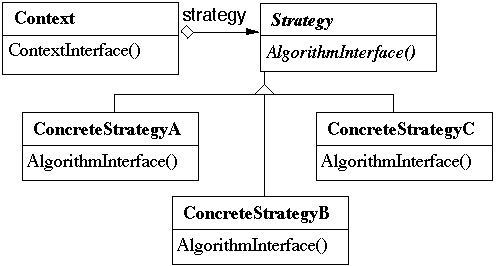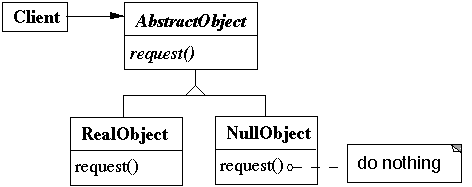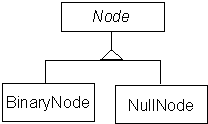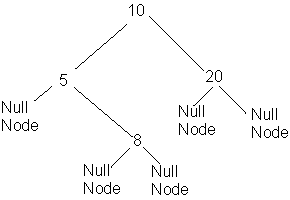
|
CS 635 Advanced Object-Oriented Design & Programming
Spring Semester, 2001
Strategy & Null Object
|
|
|
|
Previous
Lecture Notes Index
Next
© 2001, All Rights Reserved, SDSU & Roger Whitney
San Diego State University -- This page last updated 28-Feb-01
|
|
Contents of Doc 8, Strategy & Null Object
References
Design
Patterns: Elements of Reusable Object-Oriented Software
,
Gamma, Helm, Johnson, Vlissides, Addison-Wesley, 1995, pp. 315-314
“Null
Object”, Woolf, in
Pattern
Languages of Program Design
3,
Edited by Martin, Riehle, Buschmmann, Addison-Wesley, 1998, pp. 5-18
Reading
Design
Patterns:
pp.
315-314
Strategy
Intent
Define
a family of algorithms, encapsulate each one, and make them interchangeable
Strategy
lets the algorithm vary independently from clients that use it
Structure

Examples
Sorting
Different
types of sorts have different characteristics
Shellsort
-
No extra space needed, Fast but not O(n*log(n))
-
Very fast on nearly sorted data
-
Does comparatively well on small lists
Quicksort
-
Average case is O(n*log(n))
-
Relatively poor performance on short lists
-
Requires a stack of ~ log(n) in depth
MergeSort
-
Worst case is O(n*log(n))
-
Requires O(n) extra space
-
Stable
Have
a sorted list container, which one gives a sort algorithm
SortedList studentRecords = new SortedList( new ShellSort() );
studentRecords.add( “Sam” );
pubic class SortedList {
Object[ ] elements;
SortStrategy sorter;
void sort( ) {
sorter.sort( elements);
}
}
Pattern
Matching
Finding
a pattern in text is a common operation
Find
the first occurrence of the word “NullObject” in this set of notes
after this line of text.
There
are various algorithms one can use:
Brute
Force
-
Easy to implement
-
Bad worst case, but good performance in practice
KMP
-
Good worst case
Boyer-Moore
-
Excellent worst case
-
Very hard to implement
QuickSearch
-
Easy to implement
-
Good performance
-
Good worst case
State
Machines
-
Very general
Could
use a text object that has a pattern search object
Applicability
Use
the Strategy pattern when
- You
need different variants of an algorithm
- An
algorithm uses data that clients shouldn't know about
- A
class defines many behaviors, and these appear as multiple switch statement in
the classes operations
- Many
related classes differ only in their behavior
Consequences
- Families
of related algorithms
- Alternative
to subclassing of Context
- What
is the big deal? You still subclass Strategy!
- Eliminates
conditional statements
- Replace
in Context code like:
switch ( flag ) {
case A: doA(); break;
case B: doB(); break;
case C: doC(); break;
}
-
With code like:
strategy.do();
- Gives
a choice of implementations
- Clients
must be aware of different Strategies
SortedList studentRecords = new SortedList(new ShellSort());
- Communication
overhead between Strategy and Context
- Increase
number of objects
Implementation
- Defining
the Strategy and Context interfaces
- How
does data flow between them
- Context
pass data to Strategy
- Strategy
has point to Context, gets data from Context
- Strategies
as template parameters
- Can
be used if Strategy can be selected at compile-time and does not change at
runtime
SortedList<ShellSort> studentRecords;
- Making
Strategy objects optional
- Give
Context default behavior
- If
default used no need to create Strategy object
NullObject
Structure

NullObject
implements all the operations of the real object,
These
operations do nothing or the correct thing for nothing
Applicability
Use
the Null Object pattern when:
- Some
collaborator instances should do nothing
- You
want clients to ignore the difference between a collaborator that does
something and one that does nothing
- Client
does not have to explicitly check for null or some other special value
- You
want to be able to reuse the do-nothing behavior so that various clients that
need this behavior will consistently work in the same way
Use
a variable containing null or some other special value instead of the Null
Object pattern when:
- Very
little code actually uses the variable directly
- The
code that does use the variable is well encapsulated - at least in one class
- The
code that uses the variable can easily decide how to handle the null case and
will always handle it the same way
Consequences
Advantages
- Encapsulates
do nothing behavior
- Makes
do nothing behavior reusable
Disadvantages
-
- Makes
it difficult to distribute or mix into the behavior of several collaborating
objects
- May
cause class explosion
-
- Different
clients may have different idea of what “do nothing” means
-
- NullObject
objects can not transform themselves into a RealObject
Implementation
Too
Many classes
- Eliminate
one class by making NullObject a subclass of RealObject
Multiple
Do-nothing meanings
-
- If
different clients expect do nothing to mean different things use Adapter
pattern to provide different do-nothing behavior to NullObject
Transformation
to RealObject
- In
some cases a message to NullObject should transform it to a real object
- Use
the proxy pattern
Binary
Search Tree Example
Class
Structure

Object
Structure

Searching
for a Key
public class BinaryNode extends Node {
Node left = new NullNode();
Node right = new NullNode();
int key;
public boolean includes( int value ) {
if (key == value)
return true;
else if (value < key )
return left.includes( value );
else
return right.includes(value);
}
etc.
}
public class NullNode extends Node {
public boolean includes( int value ) {
return false;
}
etc.
}
Comments
on Example
- BinaryNode
always has two subtrees
- No
need check if left, right are null
- Since
NullNode has no state just need one instance
- Use
singleton pattern for the one instance
- Access
to NullNode is usually restricted to BinaryNode
-
- Forces
indicate that one may not want to use the Null Object pattern
- However,
familiarity with trees makes it easy to explain the pattern
- Implementing
an add method in NullNode
-
- Requires
reference to parent or
- Use
proxy
Copyright ©, All rights reserved.
2001 SDSU & Roger Whitney, 5500 Campanile Drive, San Diego, CA 92182-7700 USA.
OpenContent license defines the copyright on this document.
Previous
 visitors since 28-Feb-01
Next
visitors since 28-Feb-01
Next




